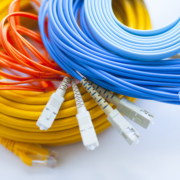What affects the Performance of Fibre Optic Cabling?
What is Fibre Optic Cabling?
Fibre performance can be affected by several reasons but 1st lets cover the basics of Fibre. Fibre optic cabling is a type of cable that uses light to transmit data. It consists of a thin, flexible strand of glass or plastic called an optical fibre. Each end of the optical fibre is connected to a transmitter and receiver. In addition, the transmitter sends pulses of light down the fibre, and the receiver converts these pulses into electrical signals.
Fibre optic cabling is used in a variety of applications. For example, telecommunications, computer networking, and data storage. It is also used in medical imaging and industrial inspection. Fibre optic cabling offers many advantages over traditional copper cabling, including higher bandwidth, lower attenuation, and immunity to electromagnetic interference.
What affects the performance of fibre optic cabling?
The performance of fibre optic cabling is affected by a number of factors such as, the type of optical fibre used, the quality of the components, and the environment in which the cabling is installed.
Type of Optical Fibre
The type of optical fibre used in a fibre optic cable can have a significant impact on its performance. The two most common types of optical fibre are single-mode and multimode.
Single-mode optical fibre is made of a single, thin strand of glass or plastic. It is used in long-distance applications, such as, telecommunications and computer networking. Furthermore, single-mode fibre optic cable has a very small core, typically 9 micrometres in diameter. This small core allows only a single mode of light to propagate down the fibre.
Multimode optical fibre is made of multiple strands of glass or plastic. It is used in shorter-distance applications, such as data storage and industrial inspection. In addition, multimode fibre optic cable has a larger core, typically 62.5 micrometres in diameter. As a result, the large core allows multiple modes of light to propagate down the fibre.
The type of optical fibre used in a fibre optic cable will determine its bandwidth and attenuation. Bandwidth is the amount of data that can be transmitted over a given period of time. Lastly, attenuation is the loss of signal strength that occurs as the light travels down the fibre.
Single-mode fibre optic cable has a higher bandwidth and lower attenuation than multimode fibre optic cable. However, single-mode fibre is more expensive and difficult to install than multimode fibre.
Quality of Components
The quality of the components used in a fibre optic cable can also affect its performance. The connectors, for example, must be properly mated in order for the light to propagate through the fibre. If the connectors are not properly mated, the light will escape from the fibre, causing signal loss.
Additionally, the quality of the optical fibre itself is also important. Optical fibre is typically manufactured to very precise specifications. If the fibre is not manufactured to these specifications, it will not perform as well as it should.
Environment
The environment in which a fibre optic cable is installed can also affect its performance. Temperature, humidity, and vibration can all cause problems for fibre optic cabling.
Fibre optic cabling is sensitive to temperature changes. If the temperature of the fibre changes too rapidly, it can cause the refractive index of the fibre to change, causing signal loss.
Fibre optic cabling is also sensitive to humidity. If the air around the fibre is too humid, it can cause the core of the fibre to absorb water, which will also cause signal loss.
Lastly, Vibration can also cause problems for fibre optic cabling. If the fibre is vibrating, it can cause the light to scatter, resulting in signal loss.
Other factors that could affect your Fibre
- Poor Installation
- Dirty Connector ends
- Patch Leads
- Crossed over patch Leads
- Poor connector termination
Conclusion
There are a number of ways to improve the performance of fibre optic cabling, including:
- Use high-quality components
- Install the cabling in a controlled environment
- Use optical fibre that is manufactured to precise specifications
- Inspect the cabling regularly for damage or contamination.
Fibre optic cabling is a critical part of many modern communications systems. Its performance can be affected by a number of factors, including the type of optical fibre used, the quality of the components, and the environment in which the cabling is installed. By using high-quality components and installing the cabling in a controlled environment, you can improve the performance of your fibre optic cabling. Contact our sales team now for a survey and quotation.





